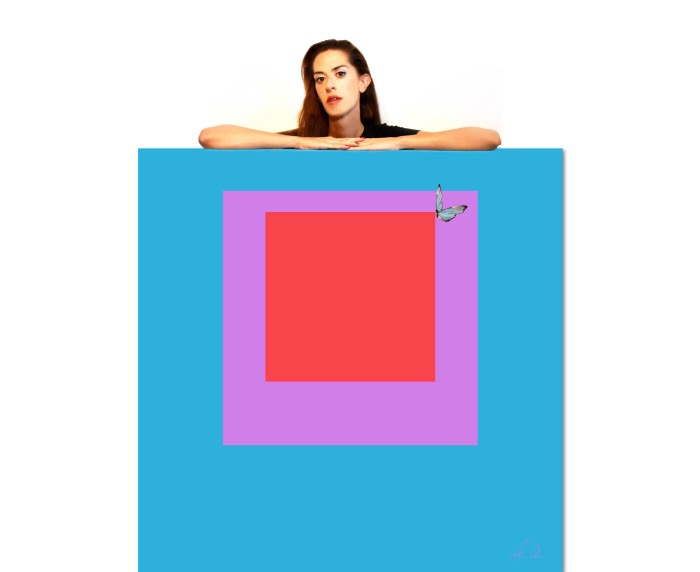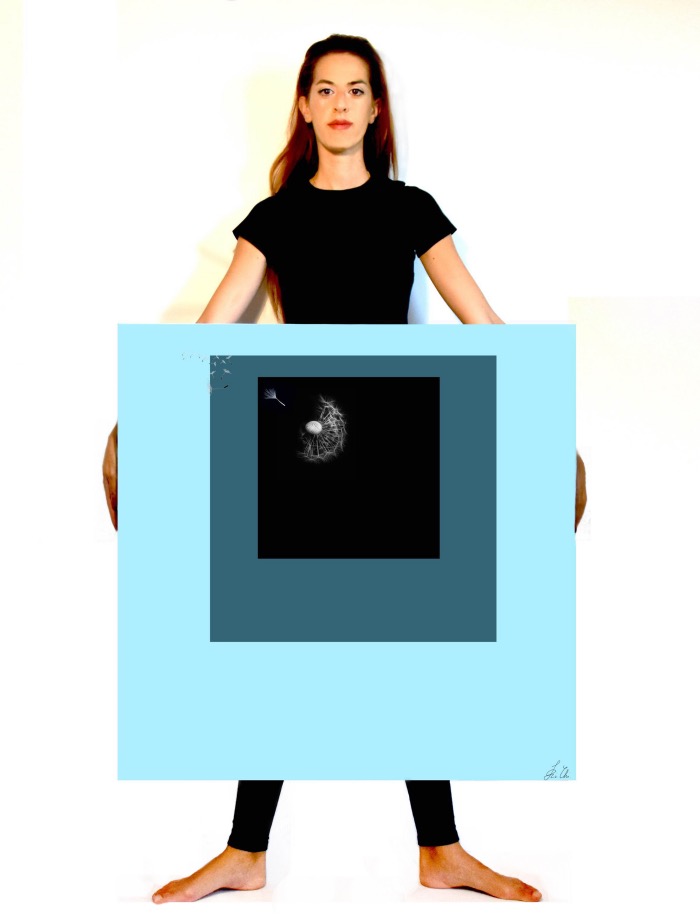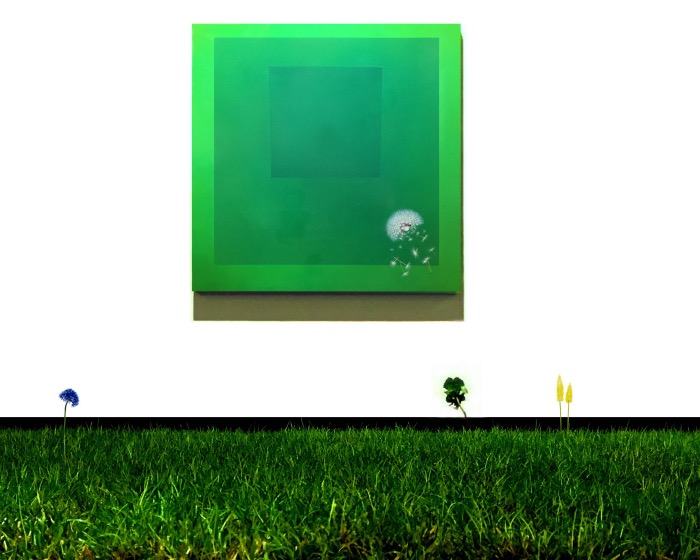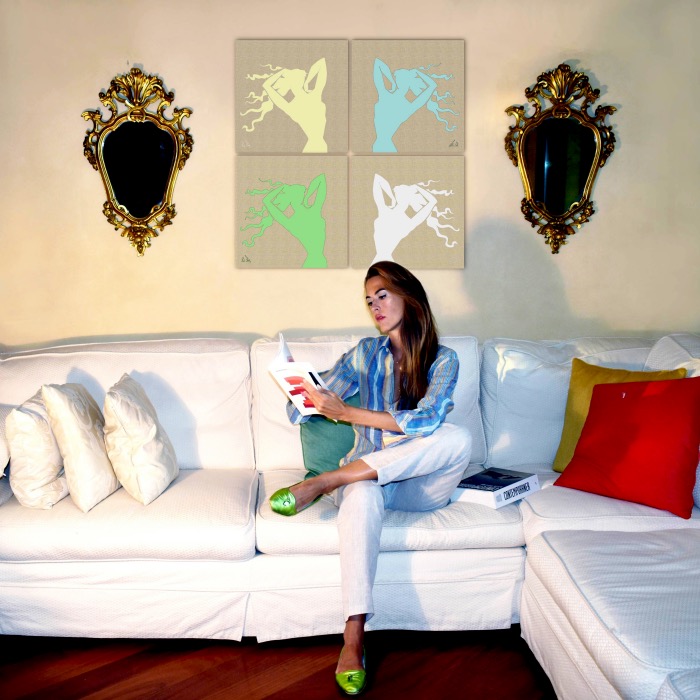
ROBERTA MARIA RICCIO CHIRIVINO, KNOWN AS RI.CHI, AND THE CREATIVE INSTANT
Roberta Maria Riccio Chirivino, known as Ri.Chi, was born in Magenta, lives between Magenta and Milan, studied at the Sorbonne University and today possesses her own studio in Milan, in Brera.
Her works are the result of inspirations and cultural roots which find their fulfillment in a “creative instant” which transforms idea into work of art.
I interviewed Ri.Chi to know her better, to understand how her works come to life and her relationship with art history, the territory she works in and latest technology.
An interview with Roberta Maria Riccio Chirivino, also known as Ri.Chi

Caterina Stringhetta: Having a look at your website, the first thing I noticed are the references to Botticelli, Michelangelo and Matisse in your works. What kind of relationship do you have with art history, and how important is it in your creative process?
Ri.Chi.: It’s fundamental. Having received a classical education, I always get inspiration from historical but also contemporary artistic expressions.
They are beginning and purpose of my creative process. They are a propulsive thrust since encourage lateral thinking and its movement between the new and the acknowledged, until it produces that “creative instant” you have to care of in order to transform it into creation not only of thinking but that can be visible to the eyes.
They are also the purpose of the work aimed at communicating a universe of symbolic references in order to encourage reflection and activate an intellectual involvement, and an aesthetic pleasure.
In relation to art history, I believe in capacity for renewal rather than in revolution and break. In this respect contemporary work of art is able to generate continually an ever new universe of references, and that is possible through a relationship and a constant dialogue with it.
For instance, the ideal of beauty and harmony represented in classical art through golden ratio proportions in some works are put in relation with vitality and spontaneous beauty of nature, especially in its simples and ordinary details.
Of course Botticelli, Michelangelo, the gouaches découpès by Matisse, the pensées visibles by René Magritte, but also Tomi Ungerer, John Heartfield, Jean-Paul Goude, Ai Weiwei, Félicien Rops, and Joseph Albers, Max Bill, Piet Mondrian are only some artists I dialogue with and I build continuous hyperlink.
Caterina Stringhetta: How do you come up with your ideas for your works?
Ri.Chi.: The ideas for my works always emerge from abundance of inspirations. Ideas need attention and rest.
I love travelling, visiting, reading, studying and understand. It’s curiosity and desire to discover, risk and embrace novelties that push and move thinking always a little beyond, towards new paths, searching for ever new meanings and inspirations.
Intellectual and visual stimuli, then, need to soak in, to be investigated and better understood, in a phase of incubation and elaboration, through streams of thought that relate them to my heritage of knowledge and experience. So, from this insight, emerges spontaneously a fast intuition I call “creative instant” that, still shrouded in mystery, brings emotion and excitement along.
The next step, instead, is based more on analysis and planning so that idea can reach concreteness and a visible result.

Caterina Stringhetta: When did you realize you would become an artist?
Ri.Chi.: I developed a passion for art since I was a child: attraction for beauty, aptitude for drawing during my childhood when I understood that art is my favourite language to express myself, and it went on, like a fil rouge, with my first sketches of evening dresses I drew at the age of 6 and my first oil paintings I painted at the age of 13.
I spent hours in the Italian museums contemplating works by our classical painters, getting as close as possible to canvases to try to understand their painting technique and see the difference between glazing and scumbling. It’s in Paris where I realized that I would become an artist, when I attended the Sorbonne University, regularly visited exhibitions and art galleries and spent time with artists and intellectuals.
So, naturally, I bought canvas and colours at Charvin and decided to transform the flat I lived in Paris into my first studio, located in Rue Berger, in 2014.
Caterina Stringhetta: You were born in Magenta, live between Magenta and Milan and today possess your own studio in Milan, in Brera. What kind of relationship do you have with your city and more generally with Lombardy and Italy? Do you think that it is important the place and artist live and work in? Or do you think it doesn’t matter, since each artist now can connect any place in the world by using the Internet and social networks?
Ri.Chi.: My first Parisian canvas portrays the dome of the Basilica of Magenta, an experiment between metaphysical painting and surrealism. And my second painting of Paris period represents a dialogue with Bellini’s Pietà: “Rêverie de voyage. Pinacothèque de Brera”. The beginning of my artistic expression was a return to the roots, by taking my own Italian identity and cultural roots back.
Magenta boasts an important history bound to the Unification of Italy, is close to the Ticino Park and Robecco sul Naviglio, places of my childhood where I can revive memories and feelings, organize the stream of experiences I enjoyed and stimuli I got. Milan is significant as well for intellectual and creative inspiration you can find there, for its artistic and cultural network and for its strategic importance in field of design, graphic design and fashion, able to launch international trends which influence also the expression of people who work in there.
This continuous and mutual exchange between art and metropolitan and cosmopolitan interior design is evident in the geometric minimalist trait of my latest works, consisting of limited and figurative details embracing the “less is more” philosophy.
Especially in the cities, overwhelmed with advertising, you can understand the importance of communicating visually in an essential way.
The Internet of things let you to expand your own world and make it remotely accessible anywhere you are. Through a tablet or a smartphone, I can welcome visitors and collectors in my studio and involve them in my creative activities. In the same way, I can keep up-to-date and exchange views through a click. I think the Internet and social media let you improve the knowledge network by broadening it far beyond the boundaries of space.
Caterina Stringhetta: What are your next projects and your dreams for the future?
Ri.Chi.: My constant commitment is to communicate a more sustainable world, in defence of environment, which is our treasure that must be protect, art is a silent activist, but powerful.
It’s possible that I will collaborate with associations that promote environmental safeguard for my next exhibition.

ALL THE INFORMATION TO FOLLOW THE WORK AND PROJECTS OF RI.CHI.
All the information to learn about Ri.Chi’s projects can be found on her website richi-art.com, but the artist is also present on social networks.
You can follow the updates on his work, his exhibitions and his initiatives on:
Facebook – https://www.facebook.com/
Instagram – https://www.instagram.com/ri.
Pinterest – https://www.pinterest.it/


Io conosco i suoi quadri sono bellissimi.
È veramente brava